
Y tu mewn i Eglwys y Drindod Sanctaidd
Mae croeso bob amser i ymwelwyr ac addolwyr i Eglwys y Drindod Sanctaidd, yr eglwys fwyaf o ddwy eglwys yr ardal weinidogaeth. Mae'n meddiannu safle ar Mostyn Street (y brif stryd drwy'r dref) ac mae'n werddon o heddwch yng nghanol tref brysur.
Bydd taith o amgylch yr eglwys yn caniatáu i harddwch y ffenestri lliw a chymhlethdodau’r cerfiadau gael eu gwerthfawrogi. Mae’r adrannau canlynol yn nodi rhai o’r eitemau o ddiddordeb ac os gallwch ymweld â’r eglwys yn bersonol gobeithiwn y byddwch hefyd yn cael amser i eistedd a gwerthfawrogi’r heddwch, i ffwrdd o brysurdeb y dref. Mae gan y siop Hadau Mwstard (gweler isod) lyfr ar hanes yr eglwys a llyfryn o fyfyrdodau ar straeon Beiblaidd a ddarlunnir yn yr eglwys.
Taith o amgylch Eglwys y Drindod Sanctaidd
Mae'r Drindod Sanctaidd yn enghraifft wych o eglwys Fictoraidd a adeiladwyd mewn arddull a oedd yn gyffredin yn y 13eg ganrif, wedi'i gorffen ar y tu allan gyda chalchfaen lleol a'i leinio â gwaith brics aml-liw, gyda charreg Caerfaddon a charreg Caen.
Mae dwy fynedfa i Eglwys y Drindod Sanctaidd: trwy'r porth gorllewinol (gyda grisiau) neu'r coridor sy'n cysylltu'r eglwys â neuadd yr eglwys (heb risiau). Mae'r daith hon yn cychwyn wrth y porth gorllewinol.
Y Porth Gorllewinol
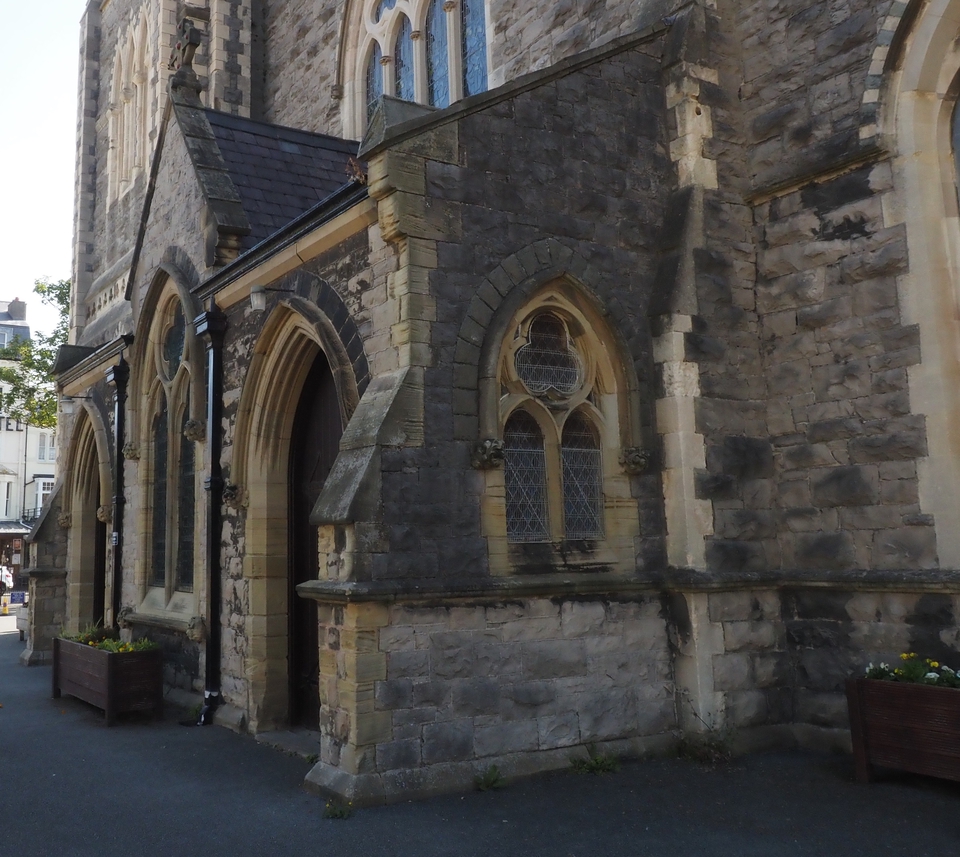
Nid oedd y porth gorllewinol yn rhan o adeiladwaith gwreiddiol Eglwys y Drindod Sanctaidd ond fe'i ychwanegwyd ar ddiwedd y 19eg Ganrif pan wnaethpwyd ymdrech i orffen yr adeilad.
Mae'r porth yn arwain i gorff yr eglwys:
Corff yr Eglwys
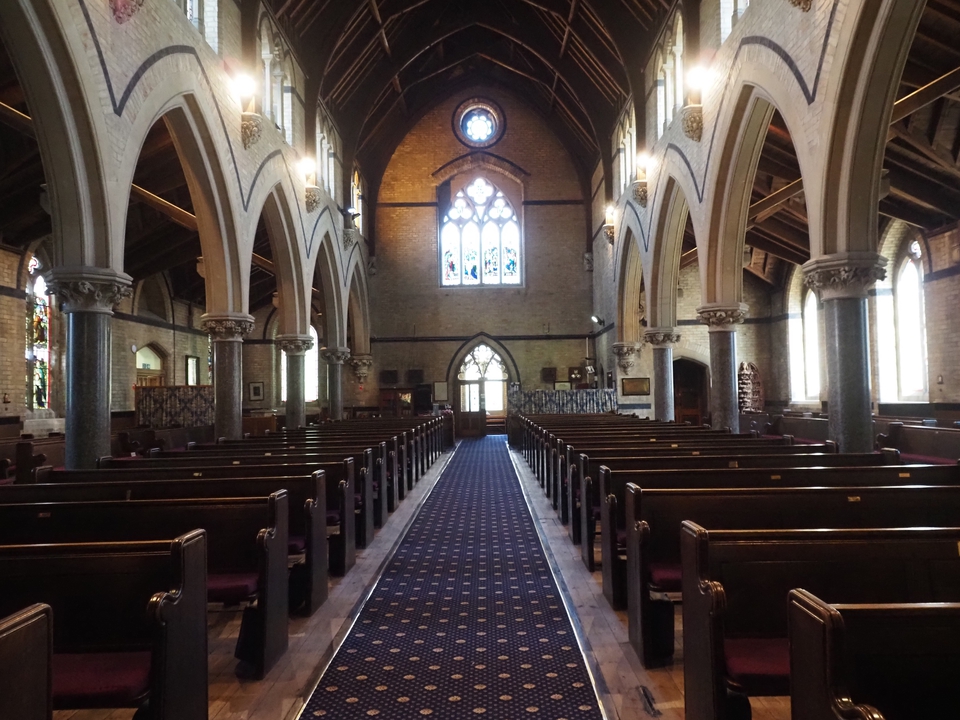
Corff yr eglwys yw prif gorff yr eglwys, lle mae'r gynulleidfa yn eistedd yn ystod y gwasanaethau. Mae'r to yn bren agored ac mae'r colofnau o farmor Môn caboledig. Mae priflythrennau’r colofnau wedi’u cerfio’n gain, gyda chynlluniau’n cynnwys blodau, ffrwythau, adar a symbolau’r pedwar awdur Efengylau, tra bod cerfiadau ar gynheiliaid tanlinell y to yn cynnwys angylion.
Mae'r daith yn symud yn glocwedd o amgylch corff yr eglwys:
Siop Hadau Mwstard
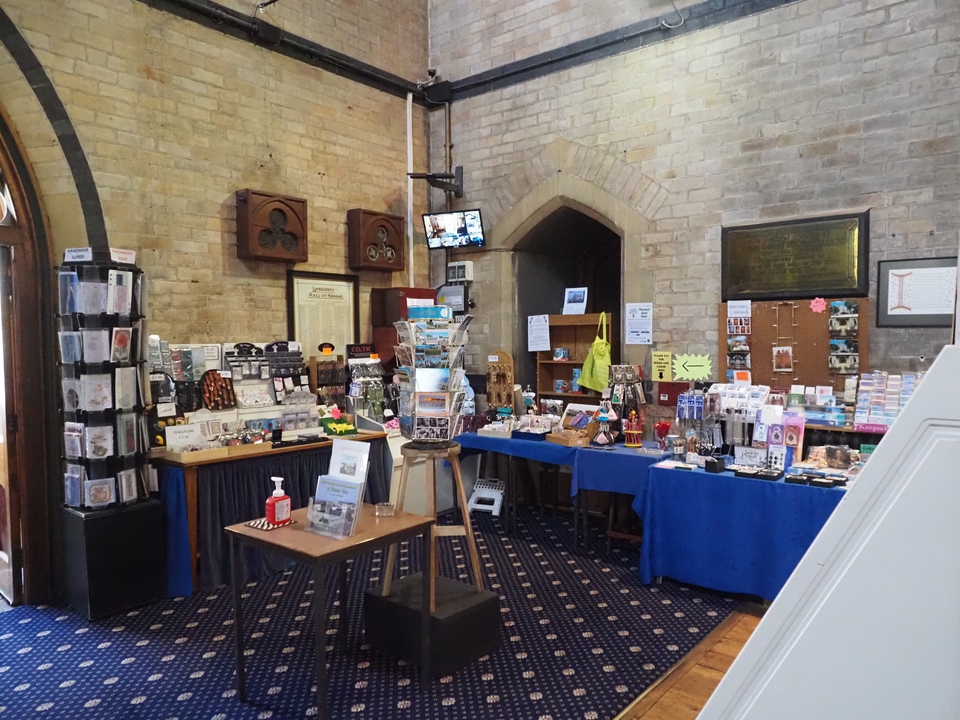
Mae’r waliau yng nghornel ogledd-orllewinol corff yr eglwys yn ffurfio sylfaen y tŵr ac mae’r siop Hadau Mwstard yn yr ardal hon. Mae'r siop ar agor ac eithrio yn ystod amseroedd gwasanaeth. Mae'r siop yn gwerthu cardiau cyfarch Cristnogol, llyfrau ac anrhegion bach. Mae myfyrdodau a gwybodaeth am hanes y Drindod Sanctaidd ar gael yma hefyd.
Gan barhau o amgylch gwaelod y tŵr:
Yr Angel
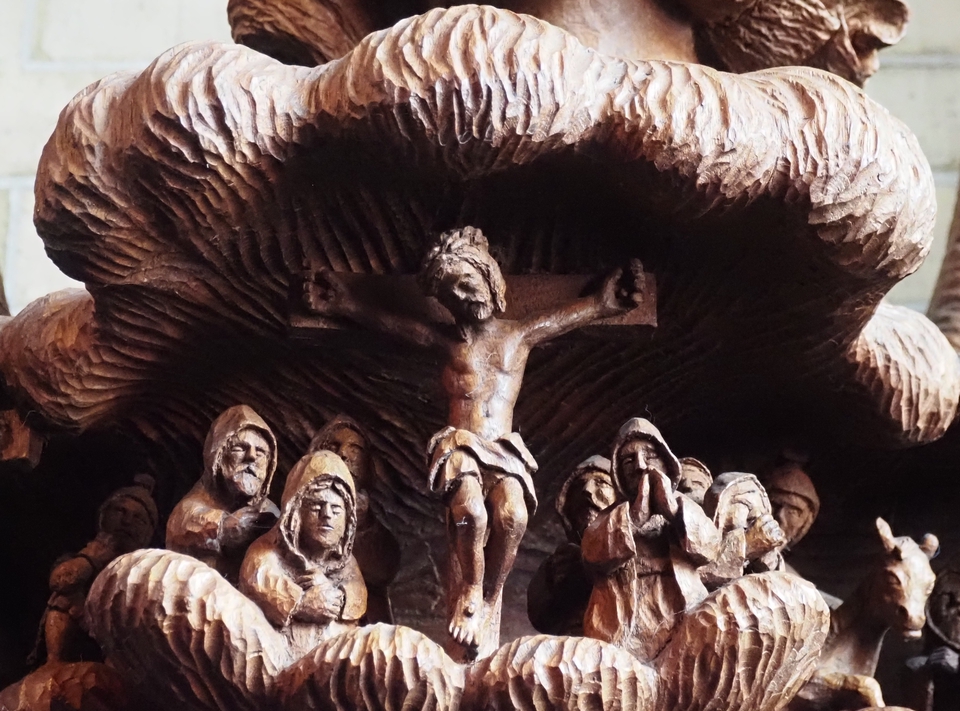
O amgylch gwaelod y tŵr mae'r Angel a gerfiwyd yn y 1970au gan Handel Edwards (1924-2011) o Sgiwen, De Cymru. O fewn adenydd eang yr Angel mae golygfeydd cerfiedig a gwyrthiau o fywyd Crist.
Gan barhau i lawr yr eil ogleddol:
Transept y Gogledd a Chapel Crist y Brenin
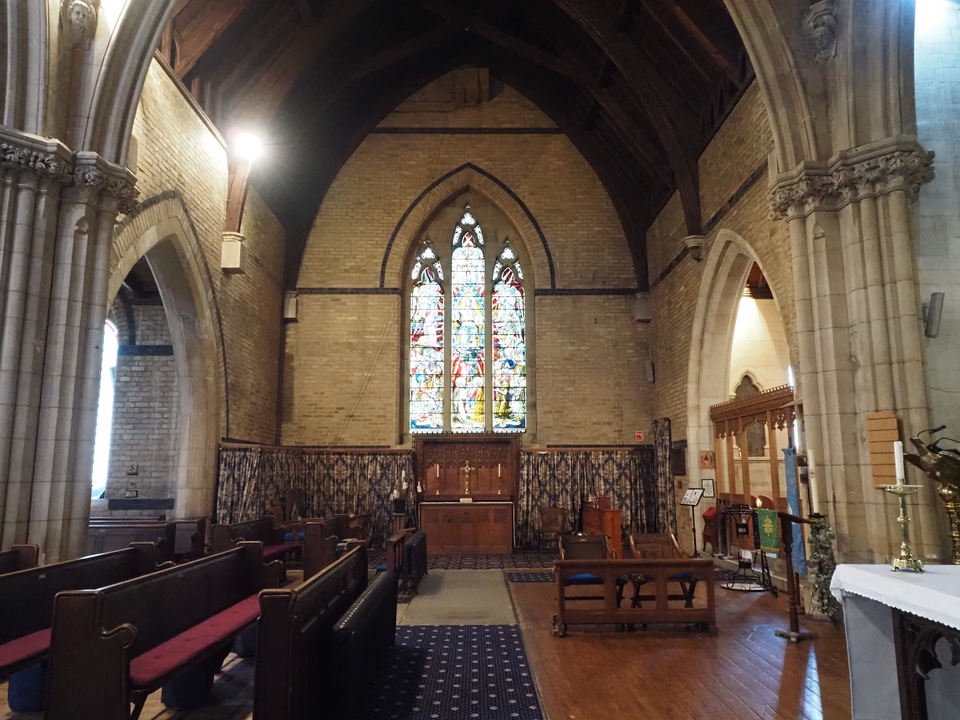
Mae Capel Crist y Brenin yn y transept gogleddol, ychydig y tu allan i'r Capel Coffa ac o dan ffenestr ogoneddus Crist ym Mawrhydi. Y transept yw'r ardal sy'n ymestyn i'r ochrau, gan roi siâp croes i'r eglwys fel y dangosir yn y cynllun.
Mae’r daith yn parhau i fyny’r grisiau i mewn i’r Capel Coffa... (Cedwir ramp cludadwy ar gyfer defnyddwyr cadeiriau olwyn yn yr ardal hon: gofynnwch i warden am gymorth.)
Y Capel Coffa

Adeiladwyd y Capel Coffa yn 1924 i goffau dynion Llandudno a fu farw yn y Rhyfel Byd Cyntaf.
Yn hongian yn y Capel Coffa mae baneri amrywiol gatrodau Cymreig a chymdeithasau gwasanaeth, sydd wedi eu gosod yno.
Defnyddir y Capel Coffa ar gyfer gwasanaethau pan ddisgwylir llai o bobl, megis yr Ewcharist am 8.00 am ar y Sul a'r 10 am ar ddydd Mercher.
Wrth y fynedfa i’r capel mae stand cannwyll addunedol, sydd ar gael i unrhyw un a hoffai gynnau cannwyll pan fyddant yn dweud gweddi.
Mae'r daith yn parhau i'r gangell trwy'r bwlch i'r dwyrain o'r consol organ...
Y Gangell a'r Cysegr

Mae'r gangell yn gartref i stondinau'r côr a'r organ, tra o fewn y cysegr mae'r Uchel Allor, lle gellir paratoi'r bara a'r gwin i ddathlu'r Cymun Bendigaid. Mae yna lawer o gerfiadau pren hardd yn yr ardal hon, gan gynnwys angylion ar bennau stondinau'r côr a'r reredos manwl iawn y tu ôl i'r Uchel Allor. Rhoddwyd y reredos cerfiedig a phanelu'r cysegr gan yr addolwyr er cof am y Parch FP Watkin-Davies, rheithor o 1925-1933.
Yr Organ
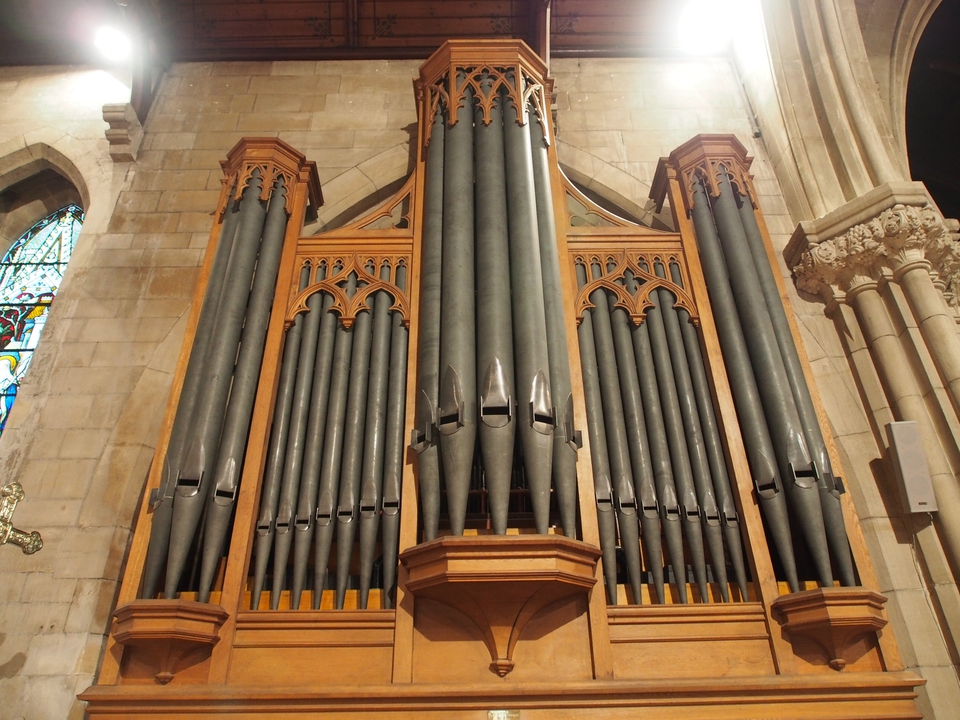
Offeryn tri llaw yw'r organ gyda mwy na 3000 o bibellau. Fe'i hadeiladwyd yn wreiddiol gan William Hill ym 1873. Cafodd ei ymestyn gan John Stringer dros y ddegawd nesaf ac fe’i hailadeiladwyd yn llwyr ym 1926 gan Rushworth a Dreaper o Lerpwl a adnewyddodd yr offeryn ym 1969. Yn 2017, gwnaeth Henry Willis o Lerpwl waith adnewyddu llwyr. Ystyrir yr organ yn un o'r offerynnau gorau yng Ngogledd Cymru.
Mae'r daith yn cymryd camau'r brif gangell i'r groesfan...
Y Groesfan

Y groesfan yw'r ardal sgwâr lle mae corff yr eglwys a'r gangell yn cwrdd â'r transept. Mae Allor Corff yr Eglwys ar y groesfan yn caniatáu i'r Cymun gael ei ddathlu yn nes at y gynulleidfa.
Ar gornel ogledd-ddwyreiniol y groesfan mae’r ddarllenfa bres, lle darllenir y Beibl yn ystod gwasanaethau. Ar yr ochr dde-ddwyreiniol y mae pwlpud derw, lle y gall yr offeiriad sefyll i bregethu. O amgylch y pulpud y mae cerfiadau yn cynrychioli y pedwar awdwr Efengylau.
Transept y De a Festri Clerigwyr
I'r de o'r groesfan mae'r transept deheuol, gydag estyniad siambr yr organ yn y gornel. Islaw’r ffenestr ddeheuol odidog mae festri’r clerigwyr, wedi’i gwahanu oddi wrth weddill yr eglwys gan sgrin bren – y bwriadwyd iddi fod yn drefniant dros dro.
Cornel y Plant

Mae hwn o flaen yr eglwys, yn yr eil ogleddol. Mae yna lyfrau, teganau a deunyddiau lluniadu i blant ifanc eu defnyddio, tra maen nhw a'u rhieni yn dal yn rhan o'r gwasanaeth.
Y Bedyddfa

Mae plant ac oedolion yn cael eu bedyddio wrth y bedyddfaen yma. Mae hwn yn agos at y fynedfa i'r eglwys fel arwydd bod bedydd yn croesawu pobl i'r eglwys.
Y Ffenestri
Mae'r ffenestri lliw yn cynnwys cyfres o olygfeydd o blentyndod Crist (yn y Cysegr), bedydd Iesu gan Ioan Fedyddiwr (yn y Bedydd), Martha a Mair (yn yr eil ddeheuol), Crist ym Mawrhydi (Capel y Brenin), Yr Annunciation (y ffenestr orllewinol) a rhai o'r seintiau Cymreig, gan gynnwys Sant Tudno, (yn y Capel Coffa).
Yng nghefn corff yr eglwys mae'r Pwll Pebble, lle gellir gosod carreg mewn pwll bach o ddŵr, fel symbol o weddi a ysgrifennwyd mewn llyfr sy'n cyd-fynd ag ef.
Mae cerfiadau pren yng nghorff yr eglwys yn cynnwys dau Lygoden Thompson a'r Angel unigryw. Roedd y gweithiwr coed enwog, Robert Thompson, bob amser yn cerfio llygoden fach fel ei llofnod ac mae’r rhain i’w gweld ar ddrws festri’r côr a’r sgrin, y ddau yn yr eil ddeheuol.
Gellir newid a datblygu eglwysi dros amser a gallwch ddarllen mwy am hanes Eglwys y Drindod Sanctaidd yma.
Inside Holy Trinity Church
Visitors and worshipers are always welcome to Holy Trinity Church, the larger of the ministry area's two churches. It occupies a site on Mostyn Street (the main street through the town) and is an oasis of peace in a busy town centre.
A tour of the church will allow the beauty of the stained glass windows and the intricacies of the carvings to be appreciated. The following sections indicate some of the items of interest and if you are able to visit the church in person we hope that you will also have time to sit and appreciate the peace, away from the bustle of the town. The Mustard Seed shop (see below) has a book on the history of the church and a booklet of reflections on Bible stories depicted in the church.
A Tour of Holy Trinity Church
Holy Trinity is a fine example of a Victorian church built in a style prevalent in the 13th century, finished on the exterior with local limestone and lined with polychromatic brickwork, with Bath and Caen stone dressings.
There are two entrances to Holy Trinity Church: through the west porch (with steps) or the corridor which links the church to the church hall (without steps). This tour starts at the west porch.
The West Porch
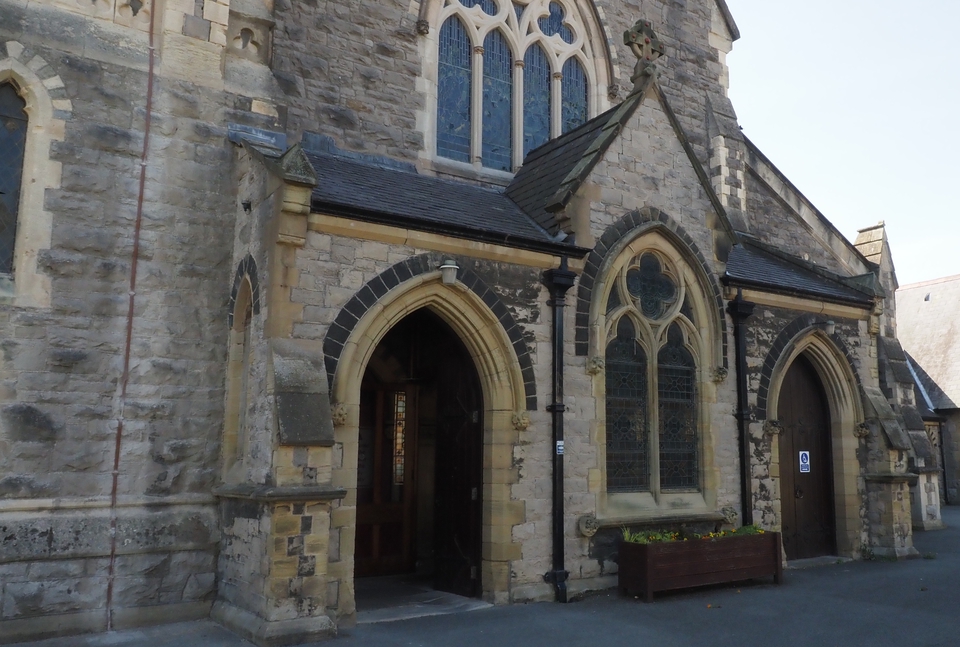
The west porch was not part of the original construction of Holy Trinity Church but was added at the end of the 19th Century when an effort was made to finish the building.
The porch leads into the nave:
The Nave
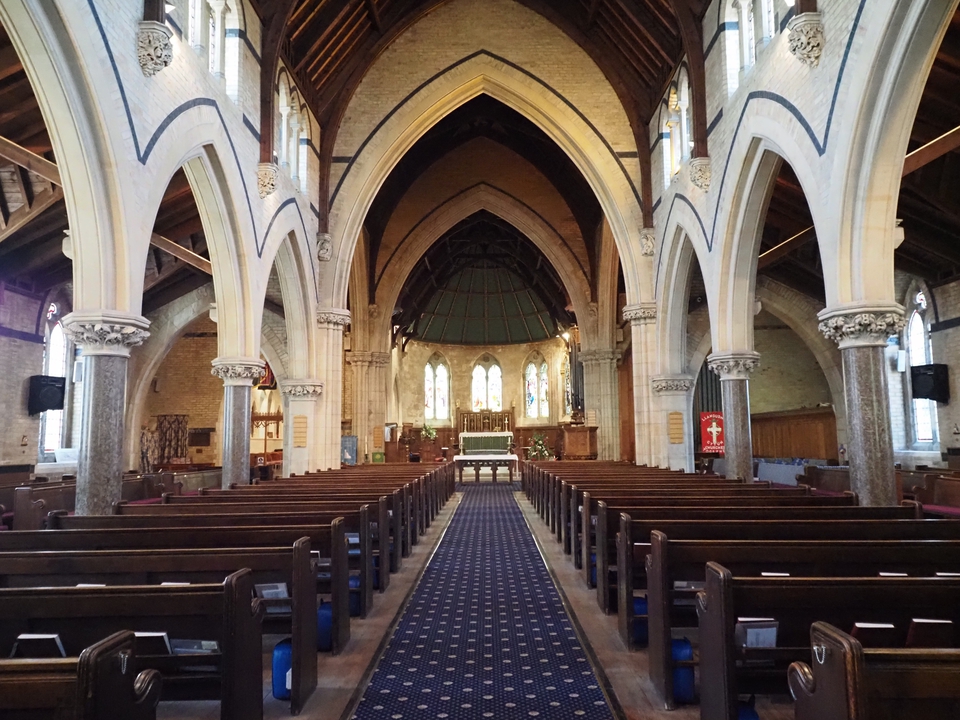
The nave is the main body of the church, where the congregation sits during the services. The roof is open timbered and the columns are of polished Anglesey marble. The capitals of the columns are delicately carved, with designs including flowers, fruit, birds and the symbols of the four Gospel writers, while carvings on the roof strut supports include angels.
The tour moves clockwise around the nave:
Mustard Seed Shop
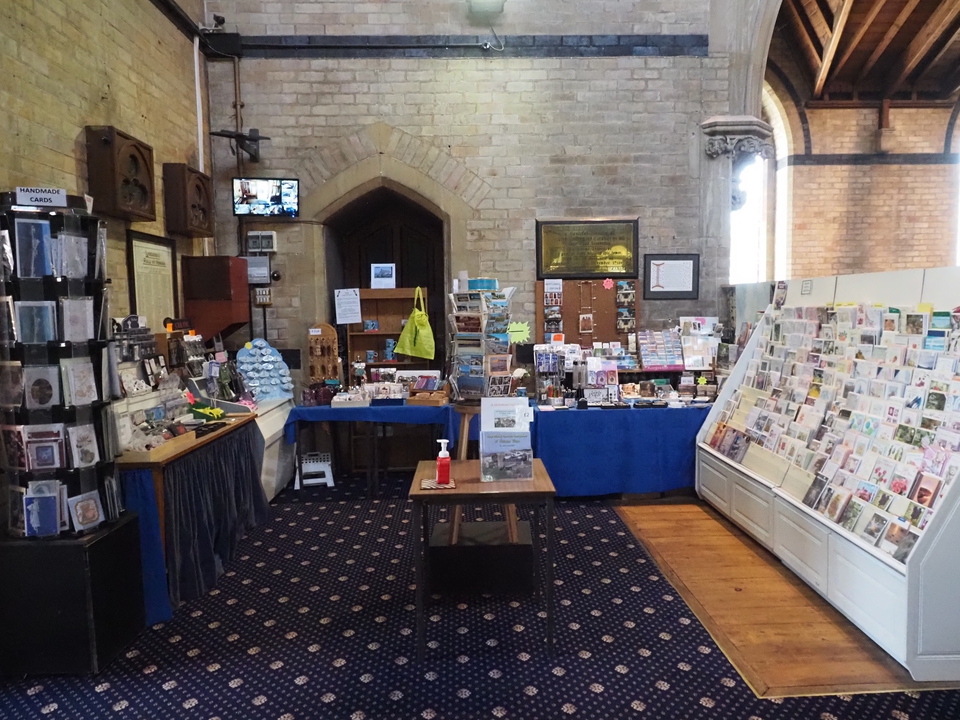
The walls in the north-west corner of the nave form the base of the tower and the Mustard Seed shop is in this area. The shop is open except during service times. The shop sells Christian greetings cards, books and small gifts. Reflections and information on the history of Holy Trinity are also available here.
Continuing around the base of the tower:
The Angel

Around the base of the tower is the Angel which was carved in the 1970s by Handel Edwards (1924-2011) from Skewen, South Wales. Within the Angel’s outspread wings are are carved scenes and miracles from the life of Christ.
Continuing down the north aisle:
North Transept and Christ the King Chapel

The Christ the King Chapel is in the north transept, just outside the Memorial Chapel and below the glorious Christ in Majesty window. The transept is the area which extends to the sides, giving the church a cross shape as shown in the plan.
The tour continues up the steps into the Memorial Chapel... (A portable ramp for wheelchair users is kept in this area: please ask a warden for help.)
The Memorial Chapel
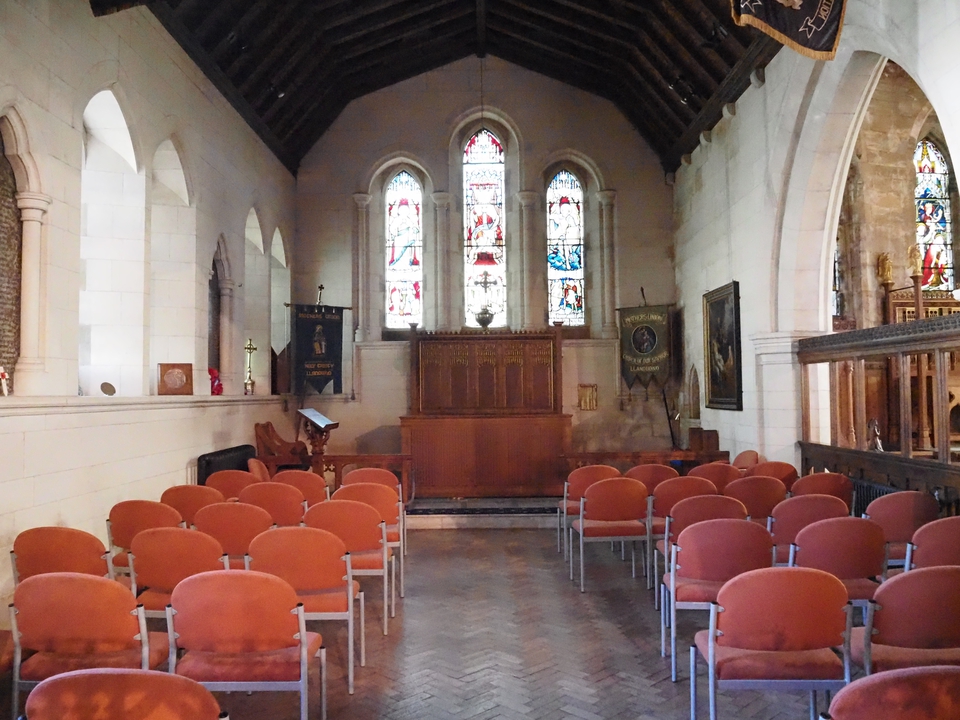
The Memorial Chapel was built in 1924 to commemorate the men of Llandudno who died in the First World War.
Hanging in the Memorial Chapel are banners of various Welsh regiments and service associations, which have been laid up there.
The Memorial Chapel is used for services when fewer people are expected, such as the 8.00 am Eucharist on Sundays and the 10 am on Wednesdays.
At the entrance to the chapel is a votive candle stand, which is available for anyone who would like to light a candle when they say a prayer.
The tour continues into the chancel through the gap east of the organ console...
The Chancel and Sanctuary
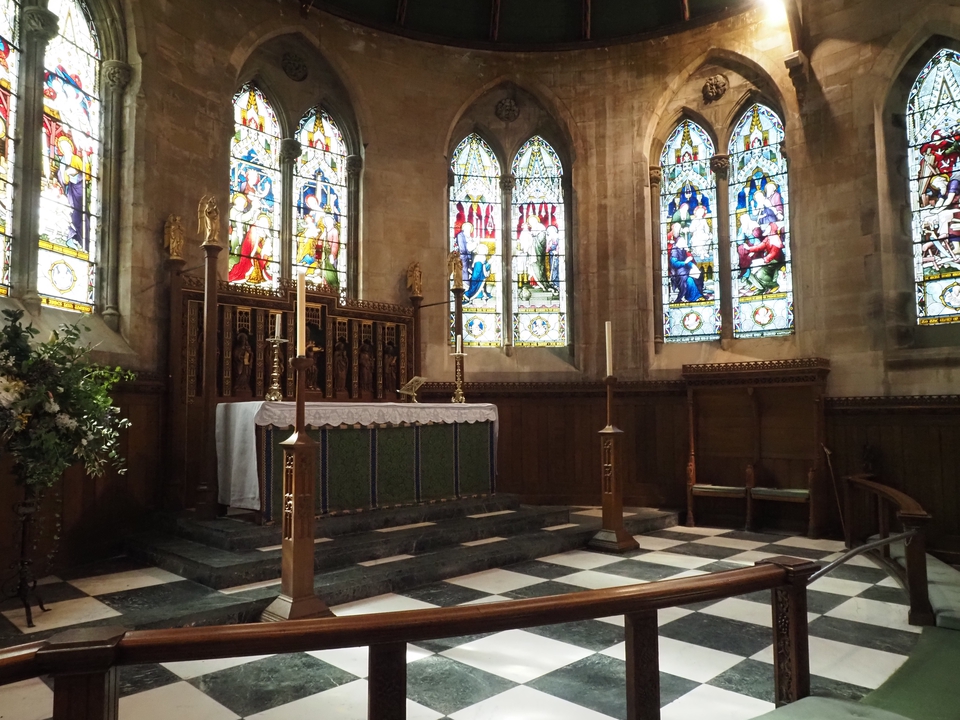
The chancel houses the choir stalls and organ, while within the sanctuary is the High Altar, where the bread and wine may be prepared in celebration of the Holy Eucharist (Communion). There are many beautiful wooden carvings in this area, including angels on the ends of the choir stalls and the very detailed reredos behind the High Altar.
The Organ

The organ is a three manual instrument with more than 3000 pipes. It was originally built by William Hill in 1873. It was extended by John Stringer over the next decade and was completely rebuilt in 1926 by Rushworth and Dreaper of Liverpool who renovated the instrument in 1969. In 2017, Henry Willis of Liverpool carried out a complete renovation. The organ is considered to be one of the finest instruments in North Wales.
The tour takes the main chancel steps into the crossing...
The Crossing
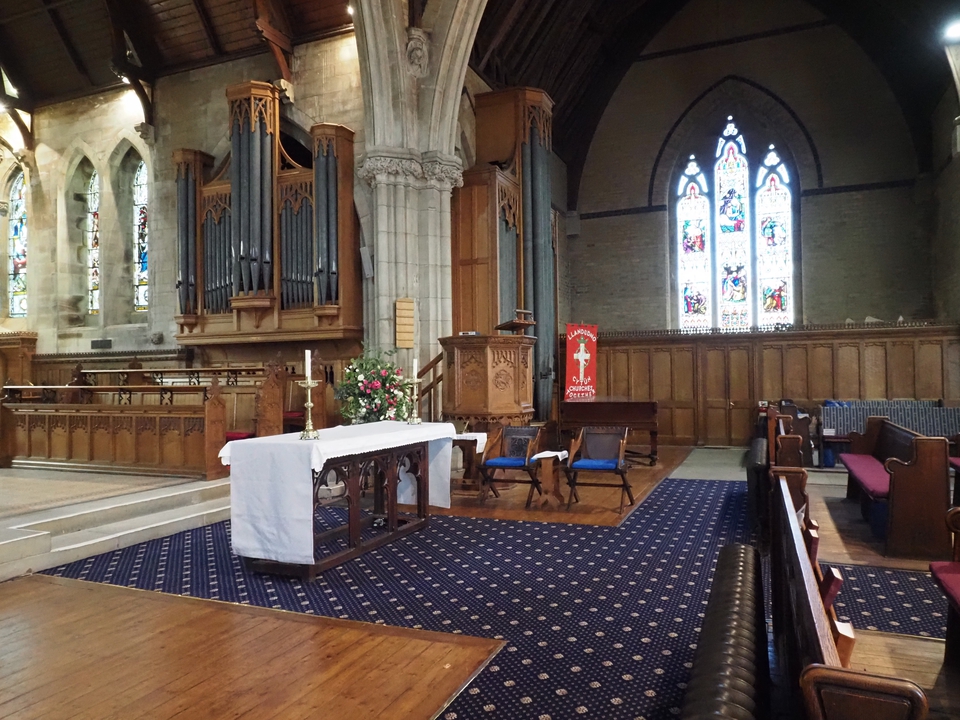
The crossing is the square area where the nave and chancel meet the transept. The Nave Altar in the crossing allows Communion to be celebrated closer to the congregation.
At the north eastern corner of the crossing is the brass lectern, where the Bible is read during services. At the south eastern side there is an oak pulpit, where the priest may stand to preach. Around the pulpit are carvings representing the four Gospel writers.
The South Transept and Clergy Vestry
To the south of the crossing is the south transept, with the organ chamber extension in the corner. Below the magnificent south window is the clergy vestry, separated from the rest of the church by a wooden screen - which was intended to have been a temporary arrangement.
Children's Corner
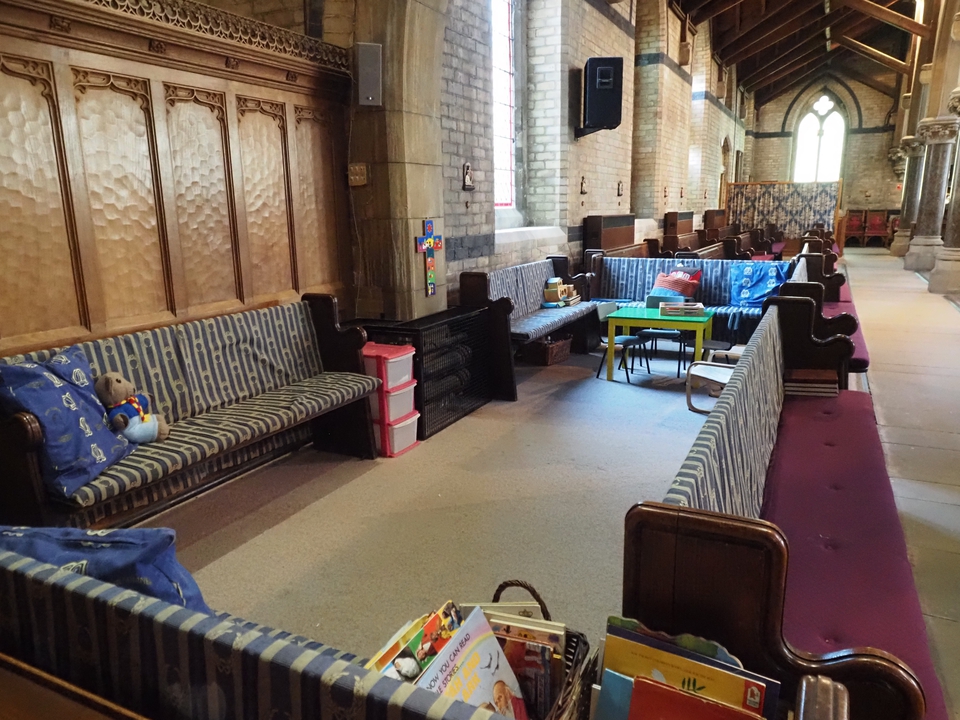
This is at the front of the church, in the north aisle. There are books, toys and drawing materials for young children to use, while they and their parents are still part of the service.
The Baptistry
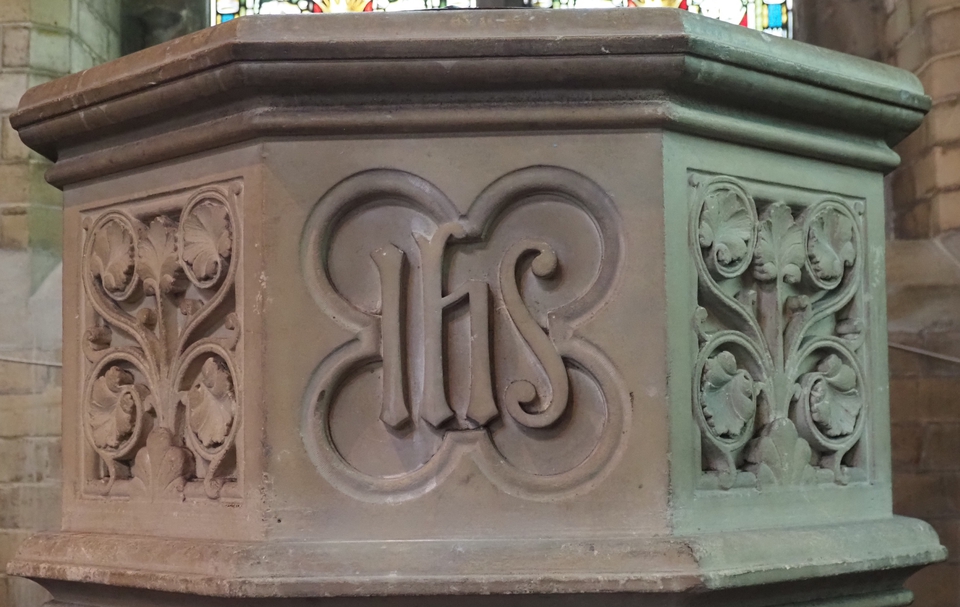
Children and adults are baptised (or Christened) at the font here. This is close to the entrance to the church as a sign that baptism welcomes people into the church.
The Windows
The stained glass windows include a series of scenes from the childhood of Christ (in the Sanctuary), the baptism of Jesus by John the Baptist (in the Baptistry), Martha and Mary (in the south aisle), Christ in Majesty (in Christ the King Chapel), The Annunciation (the west window) and some of the Welsh saints, including St. Tudno, (in the Memorial Chapel).
At the back of the nave is the Pebble Pool, where a pebble may be placed in a small pool of water, as a symbol of a prayer written in an accompanying book.
Wood carvings in the nave include two Thompson Mice and the unique Angel. The famous woodworker, Robert Thompson, always carved a tiny mouse as his signature and these can be found on the choir vestry door and the screen, both in the south aisle.
Churches can be changed and developed over time and you can read more about the history of Holy Trinity Church here.
